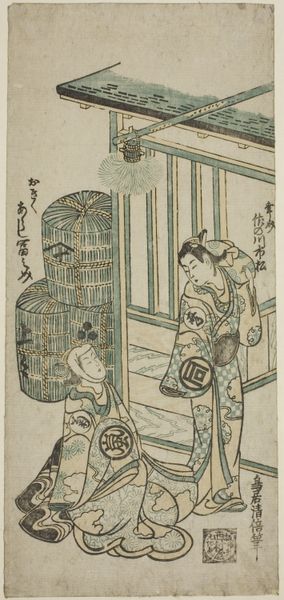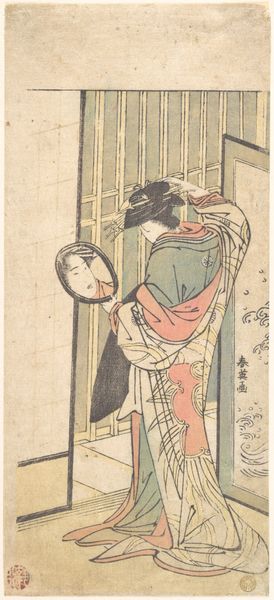
#
amateur sketch
#
toned paper
#
light pencil work
#
ink painting
# print
#
pencil sketch
#
asian-art
#
incomplete sketchy
#
japan
#
ink drawing experimentation
#
pen-ink sketch
#
watercolour illustration
#
watercolor
Dimensions: 67.8 × 11.6 cm
Copyright: Public Domain
Curator: This work presents a glimpse into domestic life through the lens of late 18th-century Japan. "Two Women and a Child after a Bath" is a print by Torii Kiyonaga dating back to around 1782, currently held at the Art Institute of Chicago. Editor: There's a tender quality here. It feels intimate, like peeking into a private moment. The colour palette seems intentionally soft, accentuating the delicate interaction. Curator: Kiyonaga’s figures were renowned for their grace and serenity, influencing portrayals of feminine ideals in Ukiyo-e prints. There's a cultural emphasis on rituals of purification and cleanliness reflected in bath houses and their symbolic connection to inner purity. Do you see it? Editor: Yes, but I also wonder about the absence of men. Are these figures representative of the era's limited socio-economic possibilities and autonomy granted to women within certain social settings? Is Kiyonaga showing us a world governed by women within certain constraints? Curator: Ukiyo-e prints such as this one became incredibly popular during the Edo period, in part due to their accessible price and relatability to everyday life. Kiyonaga moved away from the overtly theatrical figures often depicted in prints, so that they instead offered a picture of idealized contemporary life. The symbols present, though subtle, ground the artwork in time and reveal a broader narrative of the cultural context. For example, observe how carefully the hair is styled... Editor: It speaks volumes! And considering that bathhouses were centers for gossip and social exchange in the community, there's something powerful in visualizing what unfolds there through the image, particularly about how these images were consumed and spread through printmaking techniques. Curator: Precisely. He wasn’t just making an image; he was also reinforcing certain values. The print medium itself democratizes these visual ideas of family and womanhood. Editor: Examining such work is like stepping back in time, watching norms materialise as shared social consciousness. What we deem aesthetically beautiful here can reveal power structures and expectations across cultures. Curator: I agree, we've seen not just an image but a cultural artifact expressing a specific time. Editor: I’ll look at these prints quite differently going forward! Thank you.
Comments
No comments
Be the first to comment and join the conversation on the ultimate creative platform.













